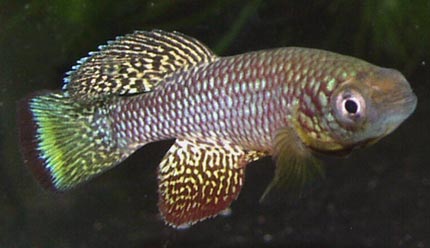October 22nd, 2007

It's hard to say what your favourite killifish species are... but in my top 5 would have to be Nothobranchius furzeri; i've been keeping the Gona-Re-Zhou furzeri on and off for some time now, a long with other Mozambique collections since they became available in 1999.
And what an interesting animal. Furzeri actually holds the record of shortest living vertebrate - you're pretty lucky if the fish live past 6 months old. Its also one of the longest kept strains in the killifish hobby, having been imported into America once in 1969 - and still going strong almost 40 years later.
It is regarded as one of the more difficult species to maintain long-term, but this need not be the case, if a few simple steps are taken.
It was initially discovered by Richard Furzer and Dr. W. Warne of the (then) Rhodesia Dept. of Agriculture, in the Sazale Pan of the Gona-Re-Zhou game reserve. The reserve had only been open since 1967, being created for the elephants in the area; Gona-Re-Zhou means “place of elephants” in the Shona language.
The original collection was given the name Nothobranchius species U-2 until it was formally described by Jubb in 1971. Nothobranchius orthonotus, (initially designated species U-3), was also present in the same pool.
So why is this species regarded as so tricky? Well there are a number of reasons, in fact common to all annual fish, but exaggerated in N. furzeri
None of these problems are insurmountable with a bit of effort
When you hatch a batch of Nothos some fish always outgrow the others. In my experience the quickest growers will always bloom magnificently and die equally quickly. These fish (typically male) reach sexual maturity after a few weeks, and last 3-4 months at most. The more slowly growing individuals take longer to sex out, but will live significantly longer than their quick-growing siblings.
Solution: It is essential to make sure that all fish have peat to lay in as soon as they need it
More so than other nothos, N. furzeri fish and fry will eat their siblings if they can. In many cases this will be the quicker growing males eating the smaller un-sexed fish. This can be a real problem with smaller hatches. If left unchecked it can result in a tank with no female fish.
Solution: Fry should have access to nourishing food at all times (Artemia, grindal worm), the more access they have to food, the less cannibalism will occur. Faster growing fish should be separated from the smaller individuals as early as a few days old. Allowing hiding spaces also helps - the rearing tank should be large enough, with clumps of free floating plantation and dim lighting.
There is little you can do to counter this. Development can take anything between a few weeks, up to several years (though usually less than one year).
Solution: Keep a lot of eggs - don't distribute too many, but most of all examine the eggs more regularly than with other species- catch them when eyed up and ready! Don't keep the eggs too warm.